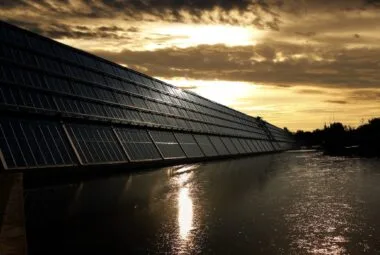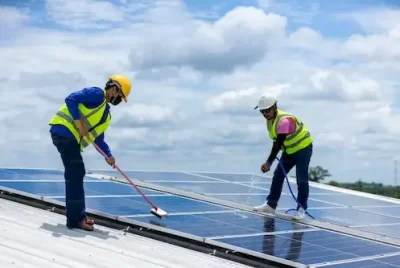Renewable Solar Energy: Sustainability Concerns in a Rapidly Expanding Market
We may earn a commission for purchases made using our links. See our disclosure to learn more.
As the sun rises on another day, its infinite radiance brings with it the promise of a greener future. The solar energy sector aka renewable solar energy, has been in the United States is ablaze with a resurgence since the Covid-induced downturn in 2020. Fueled by advanced technology, economic incentives, and an increasing recognition of our responsibility to curtail climate change. Solar system installation is reaching an all-time high, and the best solar energy companies are reaping the rewards of this exciting new dawn.
In 2023, experts predict the installation of a staggering 19 gigawatts of total solar capacity. Significantly leaping from 13 gigawatts at the end of 2019. Forward-thinking industry research already speculates that this number might quadruple within the next decade. Indeed, when factoring in the potential impact of further regulations and incentives from the environment-focused Biden administration, these optimistic projections receive even more support.
Solar Investment Tax Credit
A considerable aspect of the solar sector’s impressive resilience during the pandemic was the Solar Investment Tax Credit. This initiative lightens the financial load for both residential and commercial customers by covering 26% of all solar-related expenses, a modest drop from 30% between 2006 and 2019. The impending reduction of the tax credit to a permanent 10% for commercial installers post-2023. Coupled with its complete removal for homeowners, suggests a forecast of intensified solar sales. Consumers are predicted to race to take advantage of this incentive while it’s still available, further heating up the market.
The influx of solar power extends beyond the mere influence of tax subsidies. As technology progresses, the conversion efficiency of solar panels has been improving by up to 0.5% annually. This evolution is in parallel with a stark decrease in production costs. Thus prices are primarily attributable to several rounds of manufacturing innovation driven by the industry-dominant Chinese panel producers. Consequently, renewable solar energy is more accessible than ever before for the end consumer, translating to substantially lower upfront solar energy costs per kilowatt of energy generated.
This resounding boom in solar energy is a welcome triumph for the industry, as well as for those of us committed to the transition from fossil fuels to renewable energy sources. However, beneath this exciting surge lies a gargantuan problem, a silent echo of the solar boom that few are currently discussing.
The Dark Side of Solar
Encouragingly, economic incentives are spurring customers to swap their existing solar panels for newer, cheaper, and more efficient models. But, this phenomenon presents a significant issue – discarded solar panels. In an industry where circularity solutions, such as recycling, are inadequate, the sheer volume of disposed panels threatens to evolve into a risk of damaging proportions.
Official industry including the International Renewable Energy Agency (IRENA), forecast that we can expect large amounts of annual waste by the early 2030s, potentially accumulating up to 78 million tonnes by 2050. Rather than viewing this as a dire threat, many see it as a golden opportunity to reclaim valuable materials. However, this perception obscures a critical factor – IRENA’s predictions are based on the assumption that consumers will retain their panels for the entirety of their 30-year life cycle. What they do not factor in is the possibility of widespread early replacement.
Applying Real U.S Data
Our investigation takes a different angle. Applying real U.S. data, we constructed a model to evaluate the motivations influencing consumers’ decisions to replace their solar panels under various scenarios. We determined that three variables play a crucial role in this decision-making process: installation price, compensation rate (the current rate for solar energy sold back to the grid), and solar cell efficiency. We hypothesized that if the cost of upgrading is low enough and the efficiency and compensation rate is high enough. Then rational consumers will opt to replace their panels, regardless of whether they have reached their 30-year lifespan.
For instance, let’s take a hypothetical homeowner, “Ms. Brown”, who embarked on a solar system installation in California in 2011. In theory, she could maintain these panels for 30 years, until 2041. The total cost at the time was $40,800, 30% of which was tax-deductible due to the Solar Investment Tax Credit. Ms. Brown’s solar system was projected to generate 12,000 kilowatts of energy, approximately $2,100 worth of electricity annually. However, each subsequent year, the efficiency of her panels decreases by about one percent due to module degradation.
The Green Conundrum: Wider than Solar
The sustainability challenge does not stop with solar energy; it encompasses the broader realm of renewable technologies. Wind turbines, another cornerstone of our green future, are contributing to the waste conundrum. Without a substantial boost in processing capability, it is predicted that over the next two decades, more than 720,000 tons of mammoth wind-turbine blades will wind up in U.S. landfills.
The rapidly burgeoning electric vehicle market also faces a similar issue. 5% EV batteries are recycled as per the current estimates. This deficiency is a challenge automakers are scrambling to resolve as sales figures for electric cars continue to soar, recording an increase of up to 40% year-on-year.
Interestingly, the unique selling proposition of solar panels, compared to other green technologies, is their ability to serve as a revenue-generating engine for the consumer. Hence, in the case of solar, for large-scale adoption to occur, two separate profit-seeking actors — the panel producers and the end consumer — must be satisfied.
Towards a Brighter, Cleaner Future
Let’s be clear; these challenges shouldn’t cast a shadow over the future or the pressing need for renewable energy. The science is unequivocal: Continued reliance on fossil fuels at our current rate spells disaster for our planet and burdens future generations with a possibly dying Earth.
It takes approximately four decades for the economics of solar to stabilize when we weigh our gains against our losses. Consumers are not tempted to replace their panels prematurely at this point. However, this noble vision does not ease the reality of transitioning to renewable energy.
Of all sectors, sustainable technology can least afford to ignore the waste it produces. The necessity for a comprehensive strategy to join the circular economy is pressing. Being environmentally friendly means more than just replacing old technologies with greener alternatives. It also requires an understanding of the complete life cycle of these technologies.
The sooner we recognize this, the better because in our journey towards a brighter, cleaner future, every moment counts.
Read more at Solar Power Knowledge Hub




